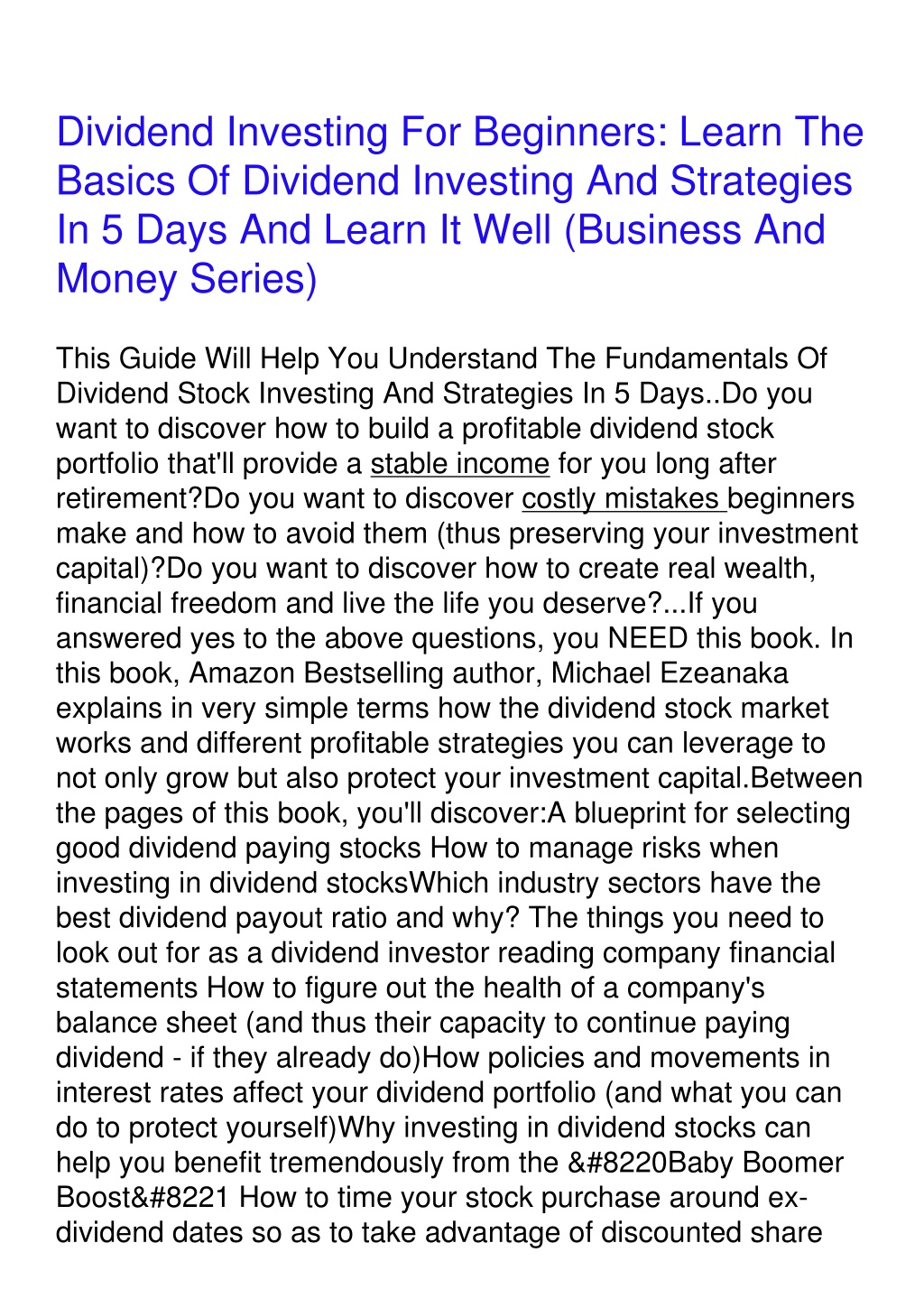Profitable Dividend Investing: Simplicity Trumps Complexity

Table of Contents
Understanding Dividend Investing Basics
What are Dividends?
Dividend investing involves owning shares of companies that regularly distribute a portion of their profits to shareholders. This payment, known as a dividend, represents a share of the company's earnings and provides a stream of passive income. The dividend yield, expressed as a percentage, represents the annual dividend per share relative to the stock price. A higher yield doesn't automatically mean better investment; it's crucial to consider the payout ratio, which indicates the percentage of earnings paid out as dividends. A sustainable payout ratio generally falls below 60%, ensuring the company can maintain dividends even during economic downturns.
Identifying Strong Dividend Stocks
Analyzing dividend-paying companies requires a thorough assessment of their financial health and future prospects. Key metrics include:
- Dividend Growth History: Look for companies with a long history of consistent dividend increases, indicating financial stability and a commitment to shareholder returns.
- Payout Ratio: A lower payout ratio (generally below 60%) suggests the company retains sufficient earnings for reinvestment and future growth, making dividends more sustainable.
- Debt-to-Equity Ratio: A lower ratio indicates less reliance on debt financing, reducing financial risk and increasing the likelihood of sustained dividend payments.
- Financial Stability: Analyze key financial statements (income statement, balance sheet, cash flow statement) to assess the company's profitability, liquidity, and overall financial strength.
Example: Look for companies with a long history of consistent dividend increases, a payout ratio below 60%, and strong balance sheets, demonstrating financial stability and a commitment to returning value to shareholders.
The Importance of Diversification
Diversification is crucial in mitigating risk. Don't put all your eggs in one basket! Diversify across various sectors and company sizes to reduce portfolio volatility. Types of diversification include:
- Sector Diversification: Invest in companies across different industries (e.g., technology, healthcare, consumer goods) to reduce the impact of sector-specific downturns.
- Company Size Diversification: Include both large-cap and mid-cap stocks in your portfolio to balance growth potential with stability.
- Geographic Diversification: Consider international stocks to further broaden your investment exposure and reduce reliance on a single country's economy.
Example: "Don't put all your eggs in one basket! Diversify across various sectors and company sizes to reduce portfolio volatility."
Simple Strategies for Profitable Dividend Investing
The Power of Dollar-Cost Averaging (DCA)
Dollar-cost averaging (DCA) involves investing a fixed amount of money at regular intervals, regardless of market fluctuations. This strategy mitigates the risk of investing a lump sum at a market high, reducing the impact of short-term volatility. DCA allows you to buy more shares when prices are low and fewer when prices are high, potentially lowering your average cost per share over time.
Reinvesting Dividends for Growth
The snowball effect of reinvesting dividends is powerful. By reinvesting your dividend payments to purchase additional shares, you accelerate your portfolio's growth through compounding. Dividend Reinvestment Plans (DRIPs) offered by many companies automate this process, often at a reduced commission cost.
- Advantages of DRIPs: Automatic reinvestment, often with no or reduced brokerage fees, fractional share purchases.
- Tax Implications: Dividends are typically taxed as ordinary income, so understanding your tax implications is crucial, but reinvesting them can defer the tax burden until the shares are sold.
Focusing on High-Quality, Established Companies
Selecting financially sound companies with proven track records is paramount. Focus on:
- Strong Financials: Consistent earnings growth, strong cash flow, and a healthy balance sheet.
- Consistent Earnings: A history of stable and growing earnings demonstrates the company's ability to generate profits and maintain dividends.
- Competitive Advantage: Look for companies with a strong competitive moat, such as brand recognition, patents, or unique business models, protecting them from competitors.
Avoiding Common Mistakes in Dividend Investing
Chasing High Yields
Beware of focusing solely on high yields without considering the underlying company's financial health. High yields can signal financial distress, increasing the risk of dividend cuts or even bankruptcy.
Ignoring Risk Management
Diversification and understanding the risks involved in individual stocks are crucial.
- Risks associated with dividend investing: Company bankruptcy, dividend cuts, market downturns.
Overcomplicating Your Strategy
Simplicity and discipline are key to long-term success in profitable dividend investing. Avoid overly complex strategies that may require significant time and expertise.
Maximize Your Returns with Profitable Dividend Investing
A simple, disciplined approach to profitable dividend investing, focusing on diversification, reinvestment, and selecting high-quality companies, is the most effective strategy. Consistent dollar-cost averaging and reinvesting dividends allow for powerful compounding effects, building a substantial passive income stream over time. Remember, simplicity trumps complexity in achieving profitable dividend investing goals.
Ready to build a passive income stream through profitable dividend investing? Start researching today and build your portfolio for long-term growth!

Featured Posts
-
 Rockys Emotional Core Stallones Favorite Film Explored
May 11, 2025
Rockys Emotional Core Stallones Favorite Film Explored
May 11, 2025 -
 Researching Debbie Elliotts Work
May 11, 2025
Researching Debbie Elliotts Work
May 11, 2025 -
 Bus Crash Leaves Prince Andrew Sexual Assault Accuser With Days To Live
May 11, 2025
Bus Crash Leaves Prince Andrew Sexual Assault Accuser With Days To Live
May 11, 2025 -
 Payton Pritchards Sixth Man Of The Year Campaign A Deep Dive
May 11, 2025
Payton Pritchards Sixth Man Of The Year Campaign A Deep Dive
May 11, 2025 -
 Le Divorce D Eric Antoine Et La Naissance De Son Bebe Avec Sa Nouvelle Compagne
May 11, 2025
Le Divorce D Eric Antoine Et La Naissance De Son Bebe Avec Sa Nouvelle Compagne
May 11, 2025
